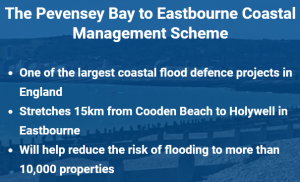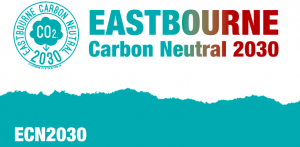Looking back on 2024, it’s clear that the transition to a Net Zero Eastbourne is gathering pace. Eastbourne DGH, through its decarbonisation project which started in 2022, has now become the first renewable heated hospital in the UK after having replaced its steam heating system with a 4.8MWth multi-stage heat pump system, which provides renewable heat to the building. Coupled with the solar PV array over one of its car parks, and a major insulation retrofit to improve the thermal efficiency of the hospital, the DGH will now be reducing its carbon emission by 4,100 tonnes per annum, amount to a cumulative total of 24,600 tonnes by 2030, a significant contribution towards the town’s Carbon Neutral 2030 target.
Another step change in Eastbourne’s renewable energy transition will occur when the Suncoast Solar Farm is built within the next few years, after having been granted planning permission by Eastbourne Borough Council earlier this year. When completed, the solar farm will have a capacity of 20MW, equivalent to supplying the power needs of 6,400 homes. This is a big step up from the mere 5 or 6 MW of solar power capacity currently installed across the borough. When local microgrids and regional energy pricing becomes a reality over the next decade or so, then the renewable power from the solar farm can be sold direct to local residents and businesses, reducing energy bills locally because solar power is so much cheaper than fossil fuels. There has understandably been much local concern about the need to protect the biodiversity of the site when the solar farm is built, and one of our members wrote a blog post about this issue, which can be adequately addressed if an appropriate biodiversity management plan is implemented, as many existing solar farms in the UK demonstrate.
 But these large projects have to be supplemented by supporting individual households across the borough to gain access to renewable energy and energy efficiency installation schemes, as domestic properties account for more than 40% of the town’s overall carbon emissions. So Eastbourne Eco Action Network (EEAN) has this year continued to develop an ever stronger partnership with Energise Sussex Coast, an award-winning community energy cooperative. Together we have developed an Eastbourne Energy Champions network of trained volunteers able to give basic energy advice to local residents and signpost them to sources of expert help – such as Energise Sussex Coast provides – if they are in fuel poverty or need to make their homes warmer. A second round of Energy Champions training began in Eastbourne a couple of weeks ago and will continue in 2025, so if you wish to receive free training to become an Energy Champion volunteer, please let us know. The more, the merrier!
But these large projects have to be supplemented by supporting individual households across the borough to gain access to renewable energy and energy efficiency installation schemes, as domestic properties account for more than 40% of the town’s overall carbon emissions. So Eastbourne Eco Action Network (EEAN) has this year continued to develop an ever stronger partnership with Energise Sussex Coast, an award-winning community energy cooperative. Together we have developed an Eastbourne Energy Champions network of trained volunteers able to give basic energy advice to local residents and signpost them to sources of expert help – such as Energise Sussex Coast provides – if they are in fuel poverty or need to make their homes warmer. A second round of Energy Champions training began in Eastbourne a couple of weeks ago and will continue in 2025, so if you wish to receive free training to become an Energy Champion volunteer, please let us know. The more, the merrier!
Another big source of carbon emissions in Eastbourne is the transport sector, which is not surprising given the high degree of dependence of the town on cars for moving around, coupled with the lack of Active Travel infrastructure such as safe cycle lanes. To raise awareness about the need to make local cycling safer, especially for kids going to school, the 4th Eastbourne Kidical Mass Bike Ride took place in May, which many EEAN members joined in with. The lack of bus lanes also restricts the quality and reliability of the local bus service, but progress toward rectifying this was achieved this year when East Sussex County Council approved plans to put bus lanes in Seaside, a key arterial road in town notorious for its traffic congestion. Many EEAN members engaged extensively with the consultation process in order to support the introduction of the bus lanes.
 But further improvements are needed to local bus services to make travelling by bus a much better alternative to driving for local residents, which is why this year EEAN set up an Eastbourne Bus User Group, bringing together local stakeholders to collaborate on making these improvements. To encourage people to think about driving less, EEAN’s EcoTransport Group once again organised a Car Free Day in Eastbourne, in Hyde Gardens. EEAN also held a very productive workshop in February about the latest Local Transport Plan (LPT4) prepared by East Sussex County Council.
But further improvements are needed to local bus services to make travelling by bus a much better alternative to driving for local residents, which is why this year EEAN set up an Eastbourne Bus User Group, bringing together local stakeholders to collaborate on making these improvements. To encourage people to think about driving less, EEAN’s EcoTransport Group once again organised a Car Free Day in Eastbourne, in Hyde Gardens. EEAN also held a very productive workshop in February about the latest Local Transport Plan (LPT4) prepared by East Sussex County Council.
For a fuller picture of all that is being done in Eastbourne to make the town more sustainable and carbon free, please look at our One Planet Eastbourne community ecosystem digital platform, which is hosting plans made by some local businesses, including those who get free support from EEAN to help devise such plans. Some local businesses do show great climate leadership through their efforts to become more eco-friendly and environmentally sustainable, and Richard Garland gave a keynote speech at our Eastbourne Carbon Neutral 2030 Symposium earlier this year to explain how his business is progressing on its sustainability journey.
 Given that the impacts of climate change are arriving thick and fast now, the need for climate adaptation is becoming ever more urgent. Part of such adaptation is figuring out how local food growing can be better protected from climate impacts such as increased flooding incidents, increased frequency and severity of droughts and heatwaves, and so on. EEAN has partnered up with Eastbourne Food Partnership and Blue Heart to investigate how local food growers are coping with such impacts and what strategies, if any, they are using to better adapt to those impacts. Part of that investigation involved visiting local groups involved in community food growing, such as Gather Community Garden, Pevensey Bay allotments, Pevensey & Westham Community Forest Garden, and Langney Community Centre. A presentation on EEAN’s research on local food growing and climate change was made at the recent Eastbourne Food Summit.
Given that the impacts of climate change are arriving thick and fast now, the need for climate adaptation is becoming ever more urgent. Part of such adaptation is figuring out how local food growing can be better protected from climate impacts such as increased flooding incidents, increased frequency and severity of droughts and heatwaves, and so on. EEAN has partnered up with Eastbourne Food Partnership and Blue Heart to investigate how local food growers are coping with such impacts and what strategies, if any, they are using to better adapt to those impacts. Part of that investigation involved visiting local groups involved in community food growing, such as Gather Community Garden, Pevensey Bay allotments, Pevensey & Westham Community Forest Garden, and Langney Community Centre. A presentation on EEAN’s research on local food growing and climate change was made at the recent Eastbourne Food Summit.
Other highlights this year was exhibiting at the Spring Water Festival Eco Fair, wonderfully organised by Plastic Free Eastbourne, and engaging with the pop-up Climate Hubs in the Beacon shopping centre in collaboration with volunteers from the Eastbourne Climate Coalition. We’ve also engaged with the hard-working volunteers of the Eastbourne United Nations Association, who have a fantastically effective carbon sequestration programme that is supported by many residents and organisations in the borough, as well as by Eastbourne Borough Council. It’s also worth a shout-out to the magnificent volunteers of Treebourne, an organisation EEAN helped to develop in its early days. Treebourne has planted many thousands of new trees across the town, which will not only help wildlife but also create vital shade to help significantly cool the streets and public spaces when the inevitable intense heatwaves arrive.
 Eastbourne Borough Council continues to reduce its own carbon emissions, and the latest yearly update to its Climate Change Strategy is now available online. An independent assessment of the progress the council is making with its Climate Change Strategy, compared with all other comparable local councils, is available from Climate Emergency UK, which has a detailed scorecard for Eastbourne. EEAN continues to collaborate with the council on ways to develop and improve its climate strategy; to assist this collaboration, all the directors of EEAN have received the Certificate in Carbon Literacy from the Carbon Literacy Project after receiving training organised by Community Energy South.
Eastbourne Borough Council continues to reduce its own carbon emissions, and the latest yearly update to its Climate Change Strategy is now available online. An independent assessment of the progress the council is making with its Climate Change Strategy, compared with all other comparable local councils, is available from Climate Emergency UK, which has a detailed scorecard for Eastbourne. EEAN continues to collaborate with the council on ways to develop and improve its climate strategy; to assist this collaboration, all the directors of EEAN have received the Certificate in Carbon Literacy from the Carbon Literacy Project after receiving training organised by Community Energy South.
EEAN also engages in the community consultation process that the Environment Agency organises regarding its Pevensey Bay to Eastbourne Coastal Management Scheme, which this year published its plans for protecting the local area from flooding for the period 2027 to 2037. The success of this scheme is vital if Eastbourne – a low-lying coastal community very much in the front line of climate change – is to have any kind of viable, sustainable future in the long-term.
 But while we still have our present coastline to enjoy, another EEAN project this year was to design an upgrade to the East Sussex Coastal Culture Trail, a key tourist route that connects up some of Eastbourne’s cultural assets with other cultural assets all the way to Hastings. The upgrade is necessary due to the current lack of safe connectivity between destinations along the trail, especially for walkers and cyclists. Bringing together the many stakeholders who need to collaborate on such an upgrade was a key part of the project. To facilitate that, EEAN and Bespoke Cycle Group organised a Summer Cycle Ride for them so that they could see for themselves exactly where the upgrade is needed. With Active Travel improvements to the trail, the local tourist economy would benefit from increased visitor numbers, coupled with an increased uptake in cycling, facilitating a modal shift away from car driving along the coast.
But while we still have our present coastline to enjoy, another EEAN project this year was to design an upgrade to the East Sussex Coastal Culture Trail, a key tourist route that connects up some of Eastbourne’s cultural assets with other cultural assets all the way to Hastings. The upgrade is necessary due to the current lack of safe connectivity between destinations along the trail, especially for walkers and cyclists. Bringing together the many stakeholders who need to collaborate on such an upgrade was a key part of the project. To facilitate that, EEAN and Bespoke Cycle Group organised a Summer Cycle Ride for them so that they could see for themselves exactly where the upgrade is needed. With Active Travel improvements to the trail, the local tourist economy would benefit from increased visitor numbers, coupled with an increased uptake in cycling, facilitating a modal shift away from car driving along the coast.
To conclude, I wish to express my heartfelt appreciation and thanks for the tremendous work of so many volunteers to help drive forward climate action locally, action which helps make the town better for all through co-benefits such as cleaner air, safer streets, greener public spaces, etc. We all deserve a rest over the festive period! Merry Christmas and a Happy New Year to one and all!
This Annual Review was prepared by EEAN’s Executive Director, Andrew Durling, who also prepared the Annual reviews for 2022 and 2023.












 However is seems that outside of the formal process it is possible for the various campaigning sides to agree what they think would work.
However is seems that outside of the formal process it is possible for the various campaigning sides to agree what they think would work. The same idea should also be used for cycle routes, where there is a often a consensus, that off-road routes do not cause issues for motor vehicles. Such successful schemes include Horsey Sewer, Cuckoo Trail and the A27 shared path to Firle. So let us prioritise these where possible, instead of contentious and poorly configured solutions that are ‘shoehorned’ into narrow spaces on roads and footways.
The same idea should also be used for cycle routes, where there is a often a consensus, that off-road routes do not cause issues for motor vehicles. Such successful schemes include Horsey Sewer, Cuckoo Trail and the A27 shared path to Firle. So let us prioritise these where possible, instead of contentious and poorly configured solutions that are ‘shoehorned’ into narrow spaces on roads and footways.








 Some of us from the Eastbourne Eco Action Network team paid a visit to the
Some of us from the Eastbourne Eco Action Network team paid a visit to the 
















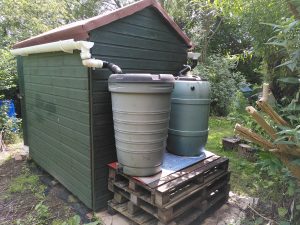
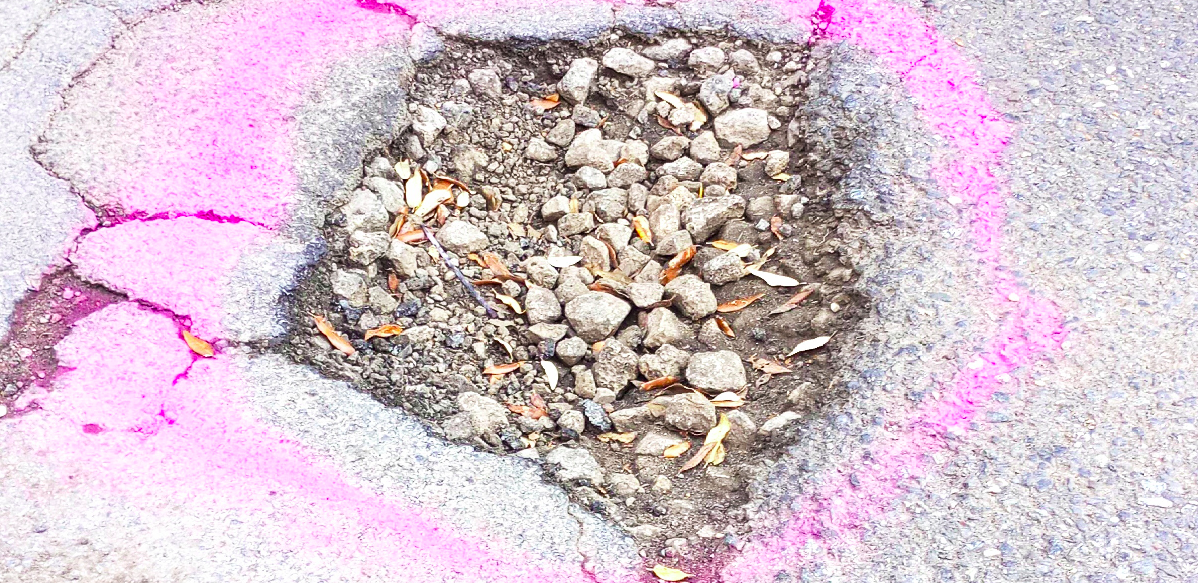






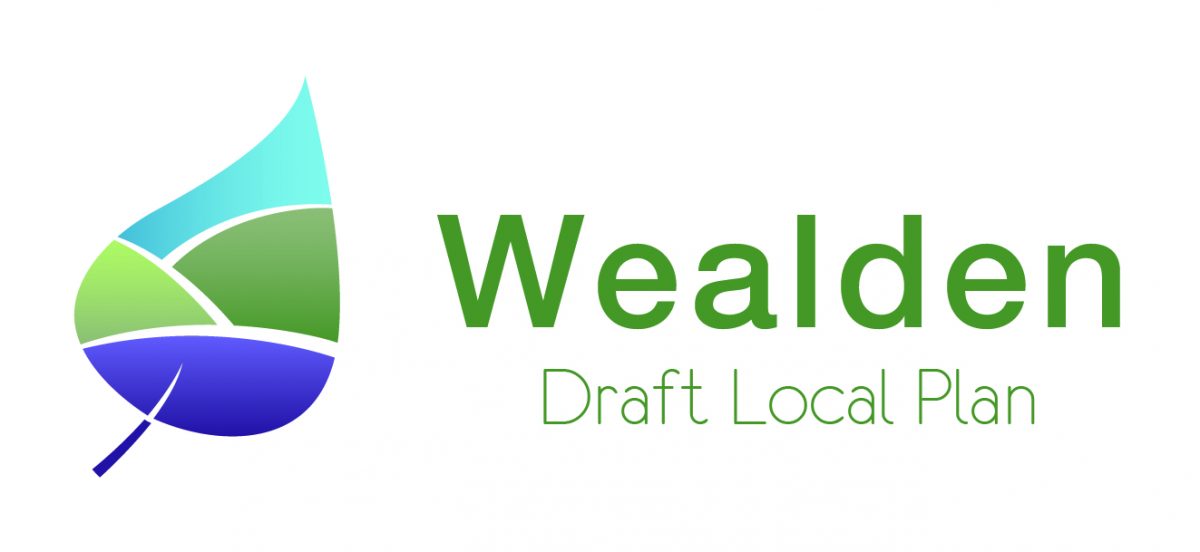
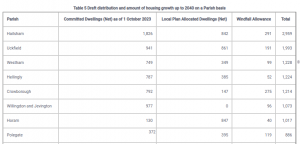
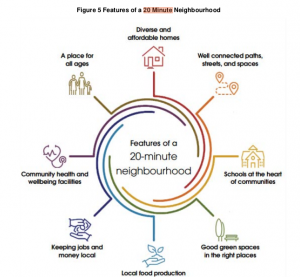
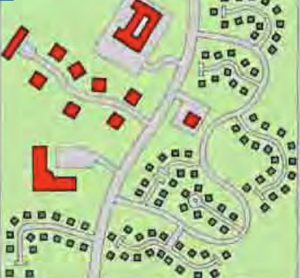
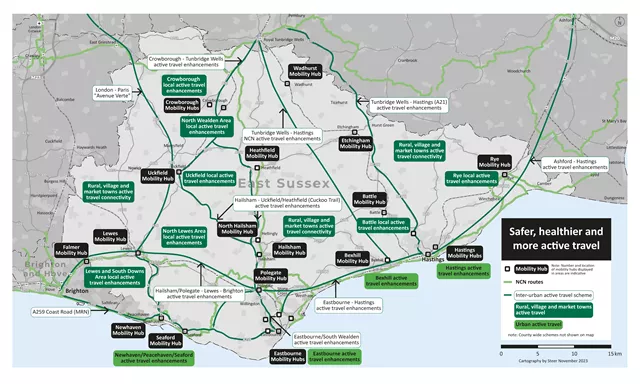
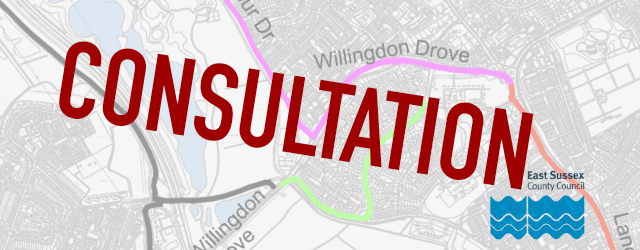
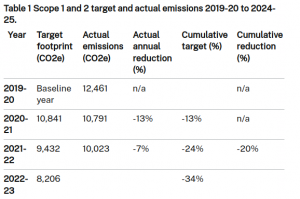

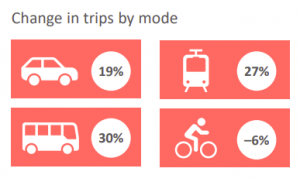 from their BAU of 2050. Then the various others scenarios are on top of this. In other words how much the trip balance will change, from BAU, with various interventions. (Note the icon with a cycle is for walking as well)
from their BAU of 2050. Then the various others scenarios are on top of this. In other words how much the trip balance will change, from BAU, with various interventions. (Note the icon with a cycle is for walking as well)
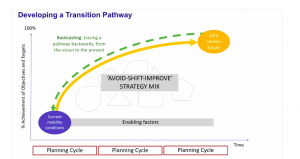

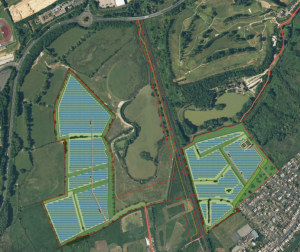
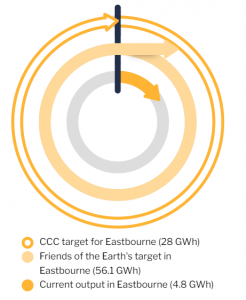
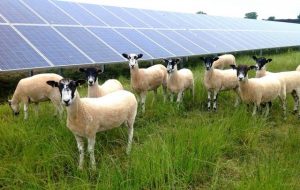
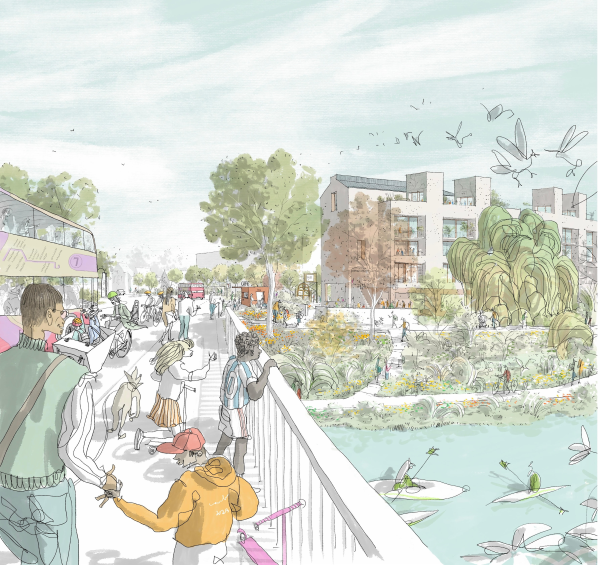


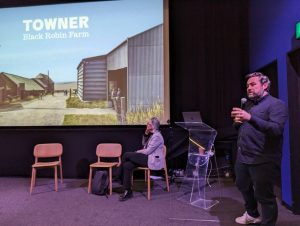 October, Eastbourne Borough Council submitted plans to the South Downs National Park Authority for its proposed
October, Eastbourne Borough Council submitted plans to the South Downs National Park Authority for its proposed 